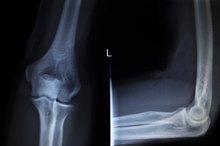How to Heal a Pulled Shoulder Muscle
Whether you did it hitting a home run or just reaching for something on a high shelf, a pulled shoulder muscle is a painful experience. A muscle pull occurs when a sudden force causes muscle fibers to stretch beyond capacity, leading to small tears in some of the muscle fibers.
The onset of the injury can be excruciatingly painful, with soreness and immobility lasting through the healing period. Depending on the severity of the injury, you can usually treat a pulled shoulder muscle at home with a combination of ice, compression and rest.
Protect It
Hopefully, as soon as you injured your shoulder you stopped doing whatever it was that caused the injury. Continuing to exercise or do yard work with an injured shoulder increases the damage, and makes recovery a more difficult and longer process. For now, your job is to protect your shoulder from anything that might cause further injury.
Ice It
How Do I Rest My Shoulder?
Learn More
Icing your shoulder regularly will help stop blood flow to the injured muscle and decrease pain and swelling. Apply ice as soon as you are able after the injury. You can use an ice pack, a bag full of ice cubes or a bag of frozen vegetables, but never apply ice directly to the skin. For the first day, apply ice to the area for 20 minutes every hour while you are awake.
Read more: 7 Workout Injury Myths That Will Wreck Your Health
- Icing your shoulder regularly will help stop blood flow to the injured muscle and decrease pain and swelling.
- For the first day, apply ice to the area for 20 minutes every hour while you are awake.
Wrap It
Compression helps to control swelling and provides support for a weakened shoulder joint. Use an athletic bandage and wrap it around your shoulder securely — but not so tight that you cut off circulation.
Wrapping your shoulder is a bit more difficult than wrapping a sprained ankle. Start by wrapping around the bicep for an anchor, then bring the bandage across the chest and under the opposite arm. Bring it back up over the injured shoulder, around the biceps again and back over the injured shoulder.
- Compression helps to control swelling and provides support for a weakened shoulder joint.
- Use an athletic bandage and wrap it around your shoulder securely — but not so tight that you cut off circulation.
Rest It
How to Treat a Rotator Cuff Injury at Home
Learn More
Your shoulder will begin healing almost immediately, but any impact can easily disrupt the process. Keep the shoulder wrapped for at least four days. During that time, continue to apply ice three or four times daily for 15 minutes at a time.
Resist the urge to use the injured shoulder and arm. Keep it elevated above your heart — not hard when you're standing or sitting, but when you're lying down you may need to prop yourself up. Avoid sleeping on your injured side.
Depending on the severity of your injury, it may take at least two weeks and up to eight weeks before you can return to your regular activities. When your pain has subsided, you can begin to gently stretch your shoulder muscles. Be careful not to overstretch them as they can easily be re-injured.
According to the Sports Injury Handbooks website, you can safely return to activity once you can move the injured shoulder without pain in the same way you can move the non-injured shoulder.
Read more: 10 Common Workout Injuries and How to Avoid Them
- Your shoulder will begin healing almost immediately, but any impact can easily disrupt the process.
- Keep it elevated above your heart — not hard when you're standing or sitting, but when you're lying down you may need to prop yourself up.
When to See a Doctor
Mild injuries can typically be treated without a visit to a doctor, but it's never a bad idea to check in with your physician by phone. More serious injuries should be looked at by a professional so you can get the proper prescription for fast healing. You may need to briefly work with a physical therapist to get back to normal as quickly as possible.
Related Articles
References
- Sports Injury Handbooks: Top 10 Sports Injuries
- SportsDoctor.com: That Painful Pull
- Elbinoune I, Amine B, Wabi M, et al. Rheumatoid shoulder assessed by ultrasonography: prevalence of abnormalities and associated factors. Pan Afr Med J. 2016;24:235. doi:10.11604/pamj.2016.24.235.9068
- Johns Hopkins Medicine. Shoulder arthritis.
- Todd DJ. Patient education: Bursitis (Beyond the basics). UpToDate. Updated January 2. 2020.
- Elbinoune I, Amine B, Wabi M, et al. Rheumatoid shoulder assessed by ultrasonography: prevalence of abnormalities and associated factors. Pan Afr Med J. 2016;24:235. doi:10.11604/pamj.2016.24.235.9068
- Arthritis Foundation. Shoulder anatomy.
- Johns Hopkins Medicine. Shoulder arthritis.
- Wang WT, Huang SW, Liou TH, et al. Patients with rheumatoid arthritis were associated with a risk of rotator cuff diseases. J Clin Med. 2019;8(2):129. doi:10.3390/jcm8020129
- Tzeng CY, Chiang HY, Huang CC, et al. The impact of pre-existing shoulder diseases and traumatic injuries of the shoulder on adhesive capsulitis in adult population: A population-based nested case-control study. Medicine (Baltimore). 2019;98(39):e17204. doi:10.1097/MD.0000000000017204
- American Academy of Orthopaedic Surgeons. Frozen shoulder. Updated March 2018.
- Todd DJ. Patient education: Bursitis (Beyond the basics). Updated January 2. 2020.
Writer Bio
Ashley Miller is a licensed social worker, psychotherapist, certified Reiki practitioner, yoga enthusiast and aromatherapist. She has also worked as an employee assistance program counselor and a substance-abuse professional. Miller holds a Master of Social Work and has extensive training in mental health diagnosis, as well as child and adolescent psychotherapy. She also has a bachelor's degree in music.






